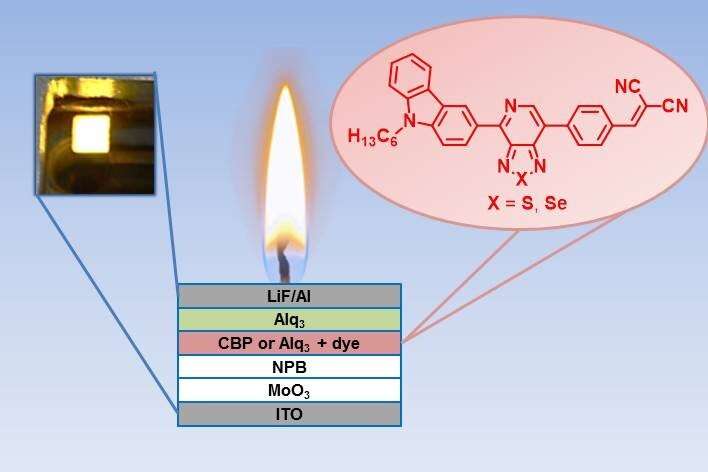Russian Scientists Create Imitating the Flame of a Candle Diodes to Cure Melancholy

Natural sunlight is the main component necessary for maintaining the life of plants, animals and people on Earth. As substitutes for natural light, people successfully use artificial lighting sources that function by burning various types of fuel, or electric light sources. Scientists of South Ural state University together with colleagues from Moscow have created innovative safe LED devices. An article about the development was published in one of the most prestigious magazines "Chemical Communications" (Scopus, Q1).
The right light for a good mood
Solar radiation has the highest quality of light, ideal for ensuring the life of humans and other living creatures, but it cannot be used for illumination at night. The safest for the human body substitute for natural light are candles, the emission spectrum of which is similar to the that of the sun at sunset or sunrise, and therefore is very physiological. The staff of the joint laboratory of South Ural State University and the Institute of Chemical Physics of the Russian Academy of Sciences cooperated with scientists from the Physical Institute named after P. N. Lebedev Russian Academy of Sciences and the D. I. Mendeleev Russian University of chemical technology. They managed to create a physiologically safe LED based on a hybrid of organic and metal-organic radiating materials, which has light characteristics similar to those of a candle flame.
"Currently, incandescent lamps with their continuous spectrum are being everywhere ousted by LED and gas-discharge sources due to their low efficiency and short service life, but the emission from these new light sources is strongly enriched with wavelengths in the blue range, which is a threat to the human eye and can cause physiological disorders in the human body," says Oleg Rakitin, doctor of Chemical Sciences, Professor.
A known problem caused by blue radiation is a noticeable decrease in the concentration of melatonin in the human body. Melatonin is known as a hormone that regulates sleep and Wake cycles (circadian or diurnal rhythms of the body), its release precedes falling asleep.
"It has been proven that maintaining an optimal level of melatonin can prevent and even treat certain types of cancer (breast cancer, prostate cancer, and colon cancer), the risk of which increases greatly with age, and a violation of circadian rhythms can lead to an imbalance of the correct metabolism in general," Oleg Rakitin explains.
The psychophysiological effect of light from sources with a linear and unbalanced spectrum should not be underestimated—such light can provoke irritability and even cause depressive states. And numerous studies on the impact of computer screens and smartphones, which also use LEDs, even show that they can accelerate aging and cause brain diseases.
The innovative composition of LED lamps
The spectrum of the luminosity of modern commercial LED light sources differs sharply from that of light sources such as flames, incandescent lamps, or sunlight. Although they can provide a visually warm yellow shade of light, they are actually a combination of blue and ultraviolet light emitted by a semiconductor crystal, and the yellow-orange glow of a special phosphor applied to it.
"The new light source, thanks to an innovative design and a combination of new specially synthesized phosphors, has virtually no harmful radiation in the blue region of the spectrum, and the color characteristics of its glow are similar to the light characteristics of the flame of ordinary candles. At the same time, such a diode is much more energy-efficient than incandescent lamps, and its brightness characteristics meet the requirements for modern light sources. On average, a LED panel made of new materials measuring 10x10 cm under optimal conditions provides the same level of illumination as 10-12 ordinary candles, while its brightness will be 4-5 times greater than a standard computer monitor," the scientist says.
Designed LEDs do not have harmful radiation in the blue range for two reasons—due to the innovative design of this led and due to the use of original dyes that have never been used to create LEDs. An important feature of the developed device is also the absence of rare and noble metals, such as iridium and platinum (the basis of modern industrial phosphors for OLED devices), and the relative simplicity of the design as a whole.
Lamps of the future
The developed devices can be used as light sources for office or other domestic premises, as elements of the lighting design of various public spaces, and for many other purposes, but their use as home lamps to facilitate falling asleep and creating comfortable soft lighting will be especially useful. The relatively simple manufacturing of these diodes and inexpensive starting materials will allow in the future to create the light sources in the form of flat panels of sufficient space with adjustable brightness and some adjustment of emission color only by changing the parameters of the supply voltage.
"We have discovered new and promising opportunities for developing cheap organic light-emitting diodes with spectral characteristics of a candle. The development of our work is planned in two main directions. The first is an extension of the range of dyes we synthesize to search for organic LEDs with optimal characteristics. And the second is the development of manufacturing technology for these LEDs, to reduce the cost of their production and implementation in practice," Oleg Rakitin shares plans for the future.
The authors of the development are confident that a high degree of cooperation and attracting new partners, both within Russia and abroad, will guarantee the successful development of this area of scientific research.
More information:
doi.org/10.1039/C9CC04973H
Provided by South Ural State University